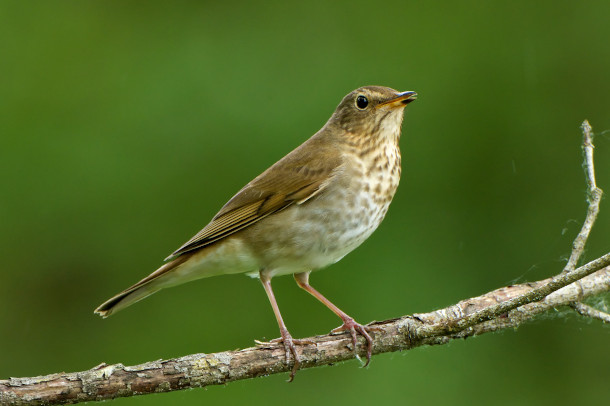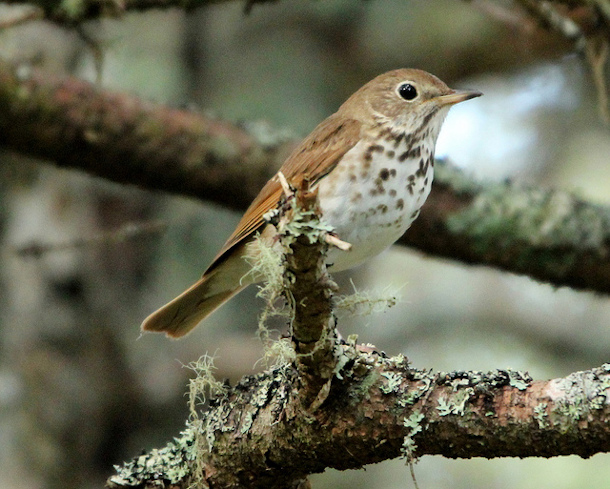BirdNote®: Salmonberry Bird
Air Date: Week of June 26, 2020

Swainson’s Thrush, also known as the Salmonberry Bird. (Photo: © Gregg Thompson)
The names of birds and other creatures often give us clues to their behavior, or an insight into their unique personalities. That’s particularly true for names derived from Indigenous groups with long histories of living closely with nature. In this week’s BirdNote® Mary McCann explains how the Salmonberry Bird came by its name.
Transcript
CURWOOD: Many geographic features in the United States derive their names from Native American words, think Dakota, Mississippi, and Iowa to name a few. And as BirdNote’s Mary McCann reports, many birds can also trace their names back to an indigenous language.
BirdNote®
Salmonberry Bird
[Song of Swainson's Thrush]
The names of birds can tell stories. We’re hearing the song of the “Salmonberry Bird,” the name indigenous Northwest Coastal people gave to the bird known in English as the Swainson’s Thrush. The Salmonberry Bird’s name comes from its annual arrival in forests across northern regions of the continent, in May, when salmonberries ripen.
The native names of birds sometimes distill the essence of their appearance or behavior. In the Cherokee language, for instance, the Meadowlark is called “star,” because of the way the bird’s tail spreads out when it soars.
[Song of the Western Meadowlark]
The Cherokee name for nuthatch is “deaf,” possibly because of the bird’s disregard for the presence of humans.
[Call of the Red-breasted Nuthatch]
The names of birds in native languages express a long affiliation between people and place. As the writer Nancy Lord observes, “Words have power. Languages connected to place help us respect local knowledge, to ask and answer the tough questions about how the human and the nonhuman can live together in a tolerant and dignified way.”

A Swainson’s Thrush perching atop a branch. (Photo: © MB McCLintock)
[Song of the Swainson’s Thrush]
The song of the Salmonberry Bird reminds us of the abiding connection between birds and people and the nourishment nature provides us both.
[Song of the Swainson’s Thrush]
###
Bird sounds provided by The Macaulay Library of Natural Sounds at the Cornell Lab of Ornithology, Ithaca, New York. Song and “quip” call of the Swainson’s Thrush and Red-breasted Nuthatch recorded by G.A. Keller. Western Meadowlark recorded by Gerrit Vyn.
Nancy Lord quote used with permission from Nancy Lord at nancylord@alaskawriters.com
Written by Todd Peterson
Producer: John Kessler
Executive Producer: Chris Peterson
© 2013 Tune In to Nature.org May 2013/2016/2020
ID# 060506SWTHKPLU SWTH-02b
https://www.birdnote.org/show/salmonberry-bird
CURWOOD: For photos make your way to the Living on Earth Website, loe.org
Links
Living on Earth wants to hear from you!
Living on Earth
62 Calef Highway, Suite 212
Lee, NH 03861
Telephone: 617-287-4121
E-mail: comments@loe.org
Newsletter [Click here]
Donate to Living on Earth!
Living on Earth is an independent media program and relies entirely on contributions from listeners and institutions supporting public service. Please donate now to preserve an independent environmental voice.
NewsletterLiving on Earth offers a weekly delivery of the show's rundown to your mailbox. Sign up for our newsletter today!
 Sailors For The Sea: Be the change you want to sea.
Sailors For The Sea: Be the change you want to sea.
 The Grantham Foundation for the Protection of the Environment: Committed to protecting and improving the health of the global environment.
The Grantham Foundation for the Protection of the Environment: Committed to protecting and improving the health of the global environment.
 Contribute to Living on Earth and receive, as our gift to you, an archival print of one of Mark Seth Lender's extraordinary wildlife photographs. Follow the link to see Mark's current collection of photographs.
Contribute to Living on Earth and receive, as our gift to you, an archival print of one of Mark Seth Lender's extraordinary wildlife photographs. Follow the link to see Mark's current collection of photographs.
 Buy a signed copy of Mark Seth Lender's book Smeagull the Seagull & support Living on Earth
Buy a signed copy of Mark Seth Lender's book Smeagull the Seagull & support Living on Earth

